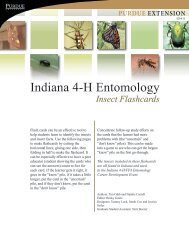The Origin of the Species? A Species Mix and Match Game - Purdue ...
The Origin of the Species? A Species Mix and Match Game - Purdue ...
The Origin of the Species? A Species Mix and Match Game - Purdue ...
You also want an ePaper? Increase the reach of your titles
YUMPU automatically turns print PDFs into web optimized ePapers that Google loves.
<strong>The</strong> <strong>Origin</strong> <strong>of</strong> <strong>the</strong> <strong>Species</strong>?<br />
A <strong>Species</strong> <strong>Mix</strong> <strong>and</strong> <strong>Match</strong> <strong>Game</strong><br />
<strong>Match</strong> <strong>the</strong> photo on <strong>the</strong> right to its origin in <strong>the</strong> column on <strong>the</strong> left.<br />
Cut along dotted line.<br />
This plant was introduced by colonial<br />
settlers in New Engl<strong>and</strong>; probably when<br />
<strong>the</strong>y discarded soil used as ballast in<br />
ships or from mud packed root balls <strong>of</strong><br />
transported plants.<br />
<strong>The</strong>se animals were brought to <strong>the</strong><br />
Americas over 10,000 years ago by<br />
nomads crossing <strong>the</strong> Bering Strait.<br />
This animal probably originated in Africa<br />
<strong>and</strong> spread from <strong>the</strong>re to Nor<strong>the</strong>rn Europe<br />
<strong>and</strong> Asia. In 1622, colonists brought <strong>the</strong>m to<br />
North America. Native Americans referred<br />
to <strong>the</strong>m as “<strong>the</strong> white man’s fly.”<br />
Early European settlers brought this<br />
herb over because it is a good source <strong>of</strong><br />
vitamins A <strong>and</strong> C. Later it was used in<br />
<strong>the</strong> NE United States as food, medicine,<br />
<strong>and</strong> erosion control.<br />
This was introduced as an ornamental<br />
l<strong>and</strong>scape plant in Philadelphia in 1756.<br />
This plant was brought to <strong>the</strong> United<br />
States in ballast in marine vessels <strong>and</strong><br />
was used as “c<strong>of</strong>fee” during <strong>the</strong> civil<br />
war.
Eight pairs <strong>of</strong> this animal were released<br />
in <strong>the</strong> spring <strong>of</strong> 1851 in Brooklyn, New<br />
York.<br />
This animal arrived as part <strong>of</strong> a planned<br />
introduction to reduce <strong>the</strong> use <strong>of</strong><br />
pesticides in <strong>the</strong> early 20th century.<br />
Scientific studies show that this plant was<br />
used as food at least 7,000 years ago in<br />
Mexico.<br />
Spanish explorers <strong>and</strong> conquistadors originally<br />
transported <strong>the</strong>se to <strong>the</strong> Americas aboard<br />
<strong>the</strong>ir ships in <strong>the</strong> 16th century. 100 years<br />
later, French fur traders <strong>and</strong> English colonists<br />
moved <strong>the</strong>m to North America.<br />
All members <strong>of</strong> this species found in<br />
North America today are descendents <strong>of</strong><br />
approximately 100 specimens released in<br />
NYC’s Central Park in <strong>the</strong> early 1890s.<br />
Grown by <strong>the</strong> Aztecs <strong>of</strong> Central America,<br />
this plant was called “xitomatl” (zee-toema-tel)<br />
which means plump thing with a<br />
navel.<br />
<strong>Origin</strong>ally, Polynesians brought <strong>the</strong>se<br />
animals to Hawaii. Later, during <strong>the</strong> 17th<br />
century, colonists released <strong>the</strong>m into<br />
forests to fend for <strong>the</strong>mselves.
















